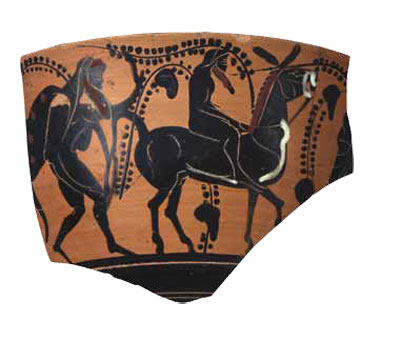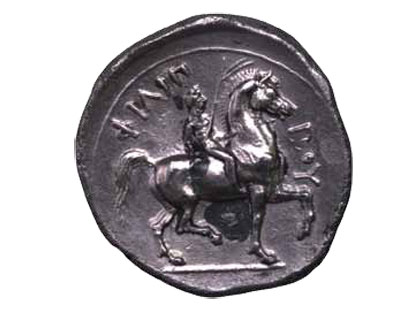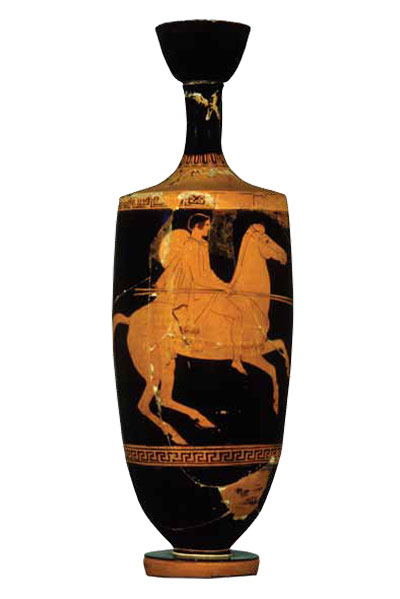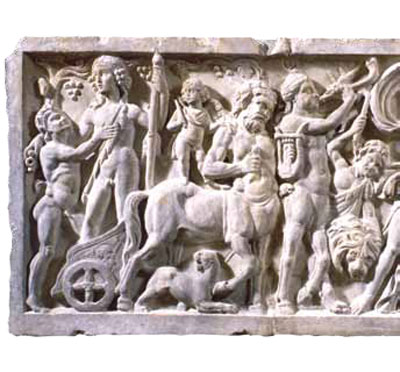
Equus caballus is handsomely stabled in the University of Pennsylvania Museum of Archaeology and Anthropology. From the Chinese Rotunda’s masterpiece reliefs portraying two horses of the Chinese emperor Taizong to Edward S. Curtis’s iconic American Indian photographs housed in the Museum’s Archives, horses stand with man in nearly every culture and time-frame represented in the Museum’s Collection (pre-Columbian America and the northern polar region being perhaps the two most obvious exceptions). Examples drawn from the more than 30,000 Greek, Roman, and Etruscan vases, sculptures, and other objects in the Museum’s Mediterranean Section serve here as a lens through which to view some of the notable roles the horse played in the classical Mediterranean world.

Museum Object Number: 29-126-581
The horse functioned as man’s inseparable and indispensible companion throughout classical antiquity. How do we know? In part because the ancient authors tell us so. From Homer’s brilliant animal similes and Xenophon’s authoritative how-to manual On Horsemanship (“The tail and mane should be washed, to keep the hairs growing, as the tail is used to swat insects and the mane may be grabbed by the rider more easily if long.”) all the way down to the 9th century AD Corpus of Greek Horse Veterinarians, which itemizes drugs for curing equine ailments as well as listing vets by name, Greek and Roman literature is filled with equine references. One recalls the cynical utterance of the 5th century BC lyric poet Xenophanes from the Asia Minor city of Colophon: “But if cattle and horses and lions had hands, or were able to do the work that men can, horses would draw the forms of the gods like ” (emphasis added by author).
The partnership between horse and master in antiquity rested on many factors; perhaps the most important was that the horse provided man with his quickest means of overland movement. Usain “Lightning” Bolt, the fastest man in the world, was traveling nearly 22 mph when he broke the world’s record for the 100 m dash in 2009, while an American quarter horse carrying a saddle and rider has been clocked at over 45 mph.
Wartime and Sporting Uses of Horses
Horse racing, with which Greek, Etruscan, and Roman society remained obsessed until the end of antiquity, was a direct outgrowth of warfare as it was practiced in the Late Bronze Age. Homer’s aristocratic Trojan and Greek heroes drove, not walked, into battle in two-horse chariots handled independently by their drivers. After casting their spears, they dismounted to continue the fight on foot. The famous funeral games staged by Achilles for his friend Patroclus featured chariot races. During the historical period Greeks and later the Romans competed with equal panache in the great panhellenic competitions at Olympia and elsewhere, and eventually in Rome’s Circus Maximus and the Hippodrome at Constantinople.

Museum Object Number: MS 2250
Their flimsy racing chariots were drawn by four horses (first introduced at Olympia in 680 BC) and later by two and three horses, but in the Roman period even bigger and more unmanageable hitches were sometimes employed. The equine equivalent of today’s overpowered formula one racing cars, these predictably led to lethal crashes, to the doubtlessly raucous approval of the fans and gamblers who routinely jammed the Circus Maximus’s 200,000-plus seats in Rome in the 2nd century AD. Flat races were first staged at Olympia in 648 BC but never seemed to gain the same popularity as chariot races. Maybe their accident quotient was simply too low. Chariots disappeared from the battle field some time following the collapse of the Late Bronze Age Mycenaean world during the murky years between ca. 1000 and 900 BC.
Cavalry, or horse mounted soldiers, enter the pages of written history for the first time during the Lelantine war (ca. 700 BC). But a full century earlier, renderings of single horses unattached to chariots had already begun to appear on pottery as well as in the form of small-scale models in clay and bronze used as votive offerings at sanctuaries like Olympia. Whether these imply the deployment of cavalry as early as the end of the 9th century BC is hard to say, but what is certain is that cavalry continued to play an important role in Greek military thinking until the end of antiquity.
The Status of Horse Owners in Society
When Athenian society was first organized for political reasons into three classes according to birth and wealth, the horse-owners or cavalrymen (hippeis) occupied the top rung of society. After Solon’s constitutional reforms in 592/91 BC, they were moved to the second of five classes which were by then determined solely on the basis of wealth. The social preeminence of horse owners continued, however, to be reflected over and over again in scenes on Attic vases showing Athenian men with their horses engaged in hunting, riding in the countryside, and other leisure time activities.


For its part, Roman society was equally conscious of the social and economic importance of horse ownership. The Roman equites or knights were initially recruited from the same ranks of the wealthy and socially prominent to serve as the Republican state’s cavalry and as such were qualified for special voting privileges. As cavalry played a smaller role in military strategy these men metamorphosed into an influential class of officials serving on the staff of governors and military commanders. From the late 1st century BC onward the so-called equestrian order was assigned a new function which had little to do with horses.
As for the Etruscans, who dominated central Italy between the Tiber and the Arno Rivers at a time when Rome was still in its infancy, we have only a meager written record and one empty of anything describable as “literature.” That said, the evidence obtained from material remains demonstrates the primacy of the horse in Etruscan society from the earliest times, when they seem to belong exclusively to the wealthy. This has continued down to the wildly popular modern Palio horse race celebrated each summer in Siena.
The Etruscan Gallery at the Penn Museum, curated by Dr. Jean Turfa of the Mediterranean Section, is one of the most important assemblages of Etruscan material in this country. Among the equine-related objects on display is a bronze bit (MS 1757) excavated from a 5th century BC burial. It features cheek pieces lined on their inner surfaces with spikes rivaling in cruelty the most extreme Spanish bit, as well as the actual teeth belonging to the animal interred alongside its master.
Blood Lines and Breeds

Museum Object Number: 29-126-58
Before turning to the Museum’s Mediterranean Collection, what can be said about the history of the horse in this region? The horse is not indigenous to Italy. It is hard to say exactly when it was introduced, but this certainly had taken place by ca. 1000 BC. To trace the blood lines of the regional breeds extant in Italy today (e.g. the Maremmano, Persano, and Napolitano) is not easily done before AD 1600 with the possible exception of the Giara, the Sardinian pony, which was supposedly introduced in ancient times by either the Carthaginians or the Greeks. Much of the essential conformation of all these breeds is owed to cross-breeding with the Arab and the North African/Spanish Barb at various moments in history. Equine breeds in existence today run from a miniature version of a horse no bigger than a medium-sized dog to heavy draught animals, which, like the peerless English Shire, can measure at the withers (shoulders) more than 18 hands (one hand = 4 inches) and weigh in at well over one ton.
The situation in the eastern Mediterranean is even more difficult to pin down. According to J.K. Anderson, the foremost authority on the Classical Greek horse, its domestication took place on the northern Asiatic steppes long before it entered the Mediterranean region and Egypt in the early second millennium BC. The Classical Greek horse familiar to us from the Parthenon frieze was warm-blooded, smallheaded, and fine-boned, although its small stature when compared with the frieze’s riders may be due to artistic license. Horses resembling the heavier “cold-blooded” (a term used to describe large and gentle horses) draught animals, which later carried the medieval knights of Europe, seem to have been known to the Persians but played no role in Greek, Etruscan, and Roman transportation and agriculture, in large measure because of the ancients’ failure to develop a proper horse collar. The other great failures were to provide stirrups and, before the Roman imperial period, iron horse shoes, which proved major impediments to capitalizing on the use of cavalry.
Equine Representations in The Mediterranean Collection

At least four equine breeds are represented by the Collection at the Penn Museum. Just how accurate they are in depicting specific types varies according to artistic convention and the familiarity of each artist to his or her subject. Our Punic electrum stater (Penn Museum 29-126-581) was struck between 310 and 270 BC 1) and must have been designed by either a South Italian or Sicilian Greek celator (coin engraver) working for Carthage, whose army was heavily dependent on cavalry drawn from its aristocracy, and utilized native, so-called Numidian horses. The free horse symbolizes a major North African natural resource as well as providing a not too subtle reference to the cavalry, the premier branch of the Punic military. As such, the coin probably portrays an early version of the Barb (a breed taking its name from berber), which the Greek artisan observed first hand on its native North African soil, or when it was being used against the Greeks in Sicily. The horses bred in eastern Libya before the arrival of the Greeks—highly sought after for chariot use by the 5th century BC—may have provided the ancestors to the North African and later Spanish Barb after the native Libyan horse had interbred with horses from Egypt.
A 4th century BC white ground rhyton or drinking horn (MS 2250) comes from Apulia in the southeast corner of Italy 2). Because Italian stock lines are basically untraceable before the 17th century AD, it is hard to pinpoint the equine type’s origin, but it could be either an import from the Greek mainland or from Sicily, with an admixture of North African blood. A sharply crested neck (topped by a cut-short, “hogged” mane), five deep creases at the top of the neck where it meets the lower jaw, and a gaping mouth are the usual hallmarks of a warm-blooded animal portrayed in a state of nervous agitation. The awkwardly stretched-out front legs are artistic short-hand for a canter or gallop.

While fragmentary, the vase MS 4873A is a masterpiece from the hand of Exekias, perhaps the greatest master of Athenian Black Figure painting 3) His refinement and sensitivity in handling the incised lines needs no further comment, but do note his exquisitely delicate rendering of the horse’s front knees, canon bones (shins), tufted fetlocks (projections above and behind the hooves), and slender pasterns (between fetlocks and hooves) connecting the legs to the hoofs. The composed but alert animal is shown quietly grazing. It illustrates the high level of success achieved by the Greeks in breeding warm bloods toward the end of the 6th century BC in the years leading up to the Persian war. The ca. 500 BC Attic Black Figure kyathos (MS 4863-12) is a small one-handled drinking cup 4) whose decorations often deal with Dionysos, the god of wine. Here a satyr, the god’s drunken companion, is set astride a braying mule (Greek hemíonos or “half-jackass”) shown stepping lightly to the right. The animal’s hiked-up tail and floppy ears may be a touch of humor. Is he intoxicated like his rider? Mules are the nearly always sterile offspring of male donkeys (the jack) and female horses (the jenny), but are never to be confused with the hinny, the spawn of male horses and female donkeys. Mules were in common use throughout antiquity.
Caballus Acceleratus: The Horse in Motion
A definitive answer to that old conundrum of whether all four feet of a galloping horse ever leave the ground at the same time had to wait until 1877. It was in that year that the British photographer Eadweard Muybridge figured out how to sequentially trip a line of cameras to prove that this was true (see page 24). In ancient times the preferred way to depict a speeding quadruped was to show the hind legs extended back while at the same time touching the ground, and the front legs thrust forward off the ground. Alternatively, the hind legs were shown gathered under the stomach; with the front legs left to “paw the air” off the ground. While the precise combinations of movements illustrated by the following figures may not occur in nature, some come close, and their creators deserve high marks for their observation skills.

The attractive silver tetradrachm (29-126-58) was circulated by Alexander the Great’s father, Philip II of Macedon, between 342 and 336 BC 5). His mount’s arched neck and rapid walking gait recall the high-stepping action of a Peruvian Paso Fino or American Saddlebred. The smaller companion coin is a silver didrachm (29-126-15) struck by the South Italian Greek city of Taras between 380 and 345 BC 6). The naked bareback rider sits his horse with a curved spine bent back off the perpendicular and feet carried well forward of the knees. This approximates the bareback positions of the 19th century American Indians and the daredevil riders competing in today’s Palio horse race in Sienna. The Museum’s masterpiece Syracusan decadrachm or ten drachm piece (29-126-41) is an exceptionally large and valuable silver coin 7) issued by Sicily’s principal city in the early years of the 4th century BC. Its designer was the renowned celator Euaenetos, whom the Syracusans honored by permitting him to sign his name to the coin in recognition of his exceptional artistic talents. The four galloping horses are displayed in three-quarter view from the front to enable the viewer to appreciate the complicated overlapping arrangement of their legs. Their driver (auriga in Greek) is crowned by a flying winged Victory or Nike. The late 6th century BC Attic Black Figure pyxis lid (MS 4845) shows three horses racing 8). What is preserved of their riders shows that they are naked as well as riding bareback and they adopt the same bareback seat illustrated by the Macedonian and Tarentine coins as well as the following Attic Red Figure lekythos (9).

The Achilles Painter, a major Athenian Red Figure artist, is the artist of this elegant vase (30-51-2). Dated to 475–450 BC, it is a striking portrayal of a warm-blooded stallion and his aristocratic rider. With his eyes rolled back and ears slightly flattened, the horse displays a degree of nervous agitation denied to his classically idealized young rider by the artistic conventions of the period just before the Parthenon’s construction. His delicate bridle does not seem to be attached to reins, an omission which seems best attributed to artistic license. Somewhat short of back and thick of barrel, the horse shares the conformation of his slightly later Parthenon frieze cousins. His unshod rear hooves are interesting as, left this way, his feet could easily lead to stumbling. His gait is another matter: Is he breaking into a canter out of a full stop, or is this the artist’s way of showing him already in motion?
The Carriage Trade
The war chariot of the Homeric age lived on in historic times not only in the enormously prestigious multiple-horse chariot races which were star events at the panhellenic games at Olympia and elsewhere, but also in the imaginative realm of art in which the gods and heroes from the past are regularly shown moving about in horse-drawn vehicles. Although these chariots can be elaborate, they usually retain the basic two-wheeled chariot design. Occasionally we catch a glimpse of contemporary war chariots, which play a very limited role in 5th and 4th century BC Greek warfare.

An Attic Black Figure hydria (51-32-1) dating to ca. 530–520 BC 11), illustrates an armed warrior’s departure for battle in the presence of his concerned elderly mentor or father; both stand behind the team of horses used to draw his biga or war chariot. Their military driver, sheathed in a long white protective chiton not unlike the dusters worn by car enthusiasts before World War I, manages the reins with masterful ease while at the same time balancing his master’s two spears in his right hand. His own shield remains sensibly strapped to his back where, even if it cannot do him much good, it at least will not get caught in the spokes. Details of the harness are meticulously rendered, along with the spirited team’s stylishly hogged manes and flowing tails. Unlike the Persians, their soon-to-be adversaries, the Greeks seldom fought from chariots at this time; this may well illustrate a Homeric scene from the heroic past.
Slightly later is an Attic Black Figure amphora (L-64- 180) from around 520–510 BC that depicts a beautifully arrayed Athena ascending her chariot drawn by a magnificent team of four jet black stallions 12).White paint was applied to the goddess’s exposed facial and body parts after the pot had been fired. Her lyre-playing brother Apollo, over whom she towers, is hailed by a loquacious but unidentifiable female (probably a goddess) similarly in-painted with white. Purple paint was then liberally applied to pick out details of the costumes of the divine protagonists as well as the horses’ tails, manes, and on the nearer horse, the narrow breast band which takes the place of a collar. With their heads tossed back, mouths opened, and ears laid flat, they present an idealized vision of animal strength and controlled energy. On a more prosaic level, note the carefully drawn spokes of the near wheel.

As a final example of equine-wheeled conveyance we find two half-horse, half-human centaurs 13) sculpted on a marble tomb loculus or cover slab (MS 4017) from the Museum’s Roman Gallery. Hybrid creatures of the imagination, centaurs share the artistic and literary stage with man from Homer’s day on, but here they date to the late 2nd or 3rd century AD. As part of the deity’s cortege of noisy celebrants, the oddly mismatched team of centaurs pulls Dionysus in a toy chariot, which, whether intentionally or not, seems to parody the ponderous triumphal carriage used to convey a Roman general during his formal triumph across the Roman Forum and up the slope of the Capitoline Hill. Staring at his unplucked lyre, the older centaur has a wearied, haggard expression, probably more the result of being worn down by the clamor going on around him than the combined weight of the young god and child Eros riding on his back. Slightly in advance of the first, the second and younger centaur blasts away with carefree abandon on a curved tuba, perhaps the ancient equivalent of the modernday soccer crowd pleaser, the vuvuzela. The artist does not bother with any distracting traces of harness. This is, after all, a divine epiphany not subject to any mortal constraints.
Horse Tales
Fables or moralizing anecdotes based on animal life (e.g. The Fox and the Grapes or The Horse, the Hunter, and the Stag) are particularly well represented throughout Greek and Latin literature, with Aesop, supposedly a 6th century BC slave from Samos, always topping the list of named fabulists. There may have also existed a parallel world of folktales familiar to the Etruscans. Although they cannot always be decoded, scenes drawn on vases comprise a cornerstone of our knowledge of Greek folktales, legends, and myths. We conclude with three vase scenes which cannot be specifically identified but which may represent illustrations of stories whose outlines would have been familiar to their ancient audiences.

An Attic Type A Red Figure amphora (MS 5399) made by the painter Psiax and the potter Menon around 520–515 BC illustrates a scene in which a young man with two spears is shown wearing a Thracian cap, high boots with natty turned-down tops, and a chiton under his short chlamys or cape 14). He leads a pair of unusually large horses by their bridles. They are collectively labeled “tawny.” They are also more specifically identified as Skonthon (Trusty) and Pyres (Fiery). These names are not otherwise known to us from Greek literature. But the inhabitants of Thrace occupying the eastern half of the Balkan Peninsula were notorious for their savage, uncivilized ways of fighting, human sacrifices, and fondness for body tattoos, all of which made them seem barbarous in the eyes of the Greeks. There is something furtive, even devious about this Thracian. Could he be stealing Trusty and Fiery? If so, this is more than just a genre scene involving taking care of animals. It may be part of an adventure story involving a crime whose ending, while lost to us, would have made sense to its viewers.

In a switch away from Athens, a handsome South Italian Greek column krater (40-34-1) made early in the 4th century BC provides an unusual narrative scene in which a cavalryman sporting high laced boots, a fancy helmet, and not much else brings his horse some grain 15). For his part the horse, with ears laid back and mouth open, steps forward briskly to receive his food from what seems to be a curiously elaborate stable structure with a roof supported by an Ionic column. While this could in theory be simply a genre scene of “life over at the stable,” there is a kind of specificity of detail that makes one wonder if the artist is not again telling us a story, the key to whose full understanding we unfortunately no longer possess.
We finally come to what is certainly the most eccentric of all the pieces from our Collection 16): an Etruscan Black Figure amphora (MS 2491) made in the late 6th century BC. Technically known as an antiglyphon, it repeats the same scene on its front and back either because its painter ran out of ideas, or because he thought that this image was simply too important not to show twice. What he has left us with is a naked rider mounted on a horse which has come within inches of colliding with an atypically aggressive deer. Nimbly rearing up on his hind legs, the anything but timid deer spins his head an alarming 180 degrees to stare down, eyeball-to-eyeball, the horse, whose alarmed reaction is to drop open its mouth and flash a truly remarkable set of equine teeth.

by the painter Psiax and the potter Menon around 520–515 BC. Museum Object Number: MS 5399
To the best of my knowledge the scene is not repeated in ancient art and does not seem to correspond to any recorded myth or fable. With that said, it has the unmistakable feel of a specific folktale, especially in details like the deer’s elegant dappled coat and saucy expression, the horse’s snarling open mouth, and even his Liberace-style poofed-up mane and unconventionally braided tail (unless the latter is a fly-net).
This brings to an end the gallop through some of the horses in the Mediterranean Section. For those who want to see more of how the classical world visually interpreted these animals, many additional pieces are on display in the galleries. By way of closing I wish to dedicate this to my wife who keeps on riding despite having broken her back twice on horseback, and to the memory of my father who was a pleasure to see sitting on a horse.
Donald White is Professor Emeritus of Classical Studies at the University of Pennsylvania and Curator Emeritus of the Mediterranean Section at the Penn Museum.


